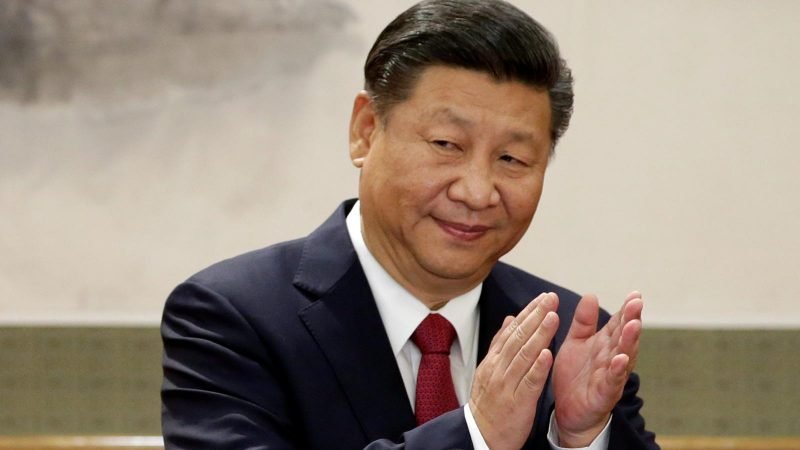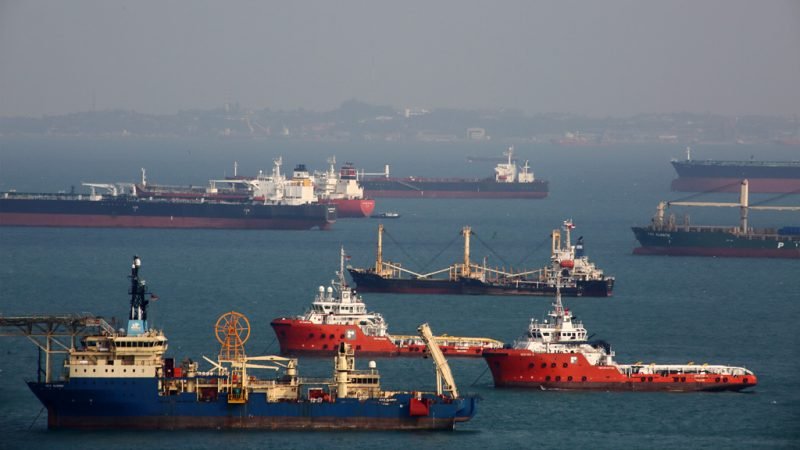Is China a ‘security threat’?

The anarchical reality in international politics has always been a motivating factor for “states to look for opportunities to maximize their power.”[1] In his opening address to the 19th National Congress of the Chinese Communist Party in 2017, China’s President Xi Jinping expressed his desire to see Beijing become “a global leader in terms of composite national strength and international influence.”[2] Analysing the tectonic shift in international politics due to its rise, this piece looks to make a coherent argument that the Chinese desire to be a global power by 2049 (the 100th year of its formation) is far from being peaceful.
John Mearsheimer, in The Tragedy of Great Power Politics, has contended that the most rational way of ensuring state security “is to be the hegemon in the system” by maximising own power compared to one’s rivals.[3] The USA was the epitome of this way of action in the post-WWII period, during which it established its hegemony.[4] But now, it is the Middle Kingdom that has compellingly embraced this notion.[5] Rightly predicting this behaviour two decades ago, Mearsheimer had anticipated China to devise its version of Monroe doctrine to dominate Asia, bestride its neighbours, and menacingly augment its military capabilities; we are now witnessing all this in the Indo-Pacific.[6]
Water, water everywhere
The virtuous principle of ‘freedom of the seas’ is more than 400 years old, first accepted in the 17th century when Hugo Grotius wrote the Mare Liberum. But for years, China has been undermining the sanctity of this idea with its expansionary efforts in the Indo-Pacific. The South China Sea (SCS) section of Indo-Pacific has been described by Kaplan as “the throat of the Western Pacific and Indian oceans – the mass of connective economic tissue where global sea routes coalesce.”[7] The region has enormous economic potential with bountiful reserves of oil and natural gas and an estimated one-third of the world’s trade volume carried through it; Beijing imperiously claims roughly 90% of the SCS citing its unilateral Nine-Dash line map.[8] As the People’s Republic of China (PRC) rides roughshod on the

maritime rights of Southeast Asian countries in the region, it has relentlessly focussed on reclaiming land and building military bases on various reefs and islands like Paracel, Spratly, amongst others. With People’s Armed Forces Maritime Militia enforcing coercive tactics and China deploying anti-ship cruise missiles in the region, the security of the sea lines of communication stands severely compromised.[9] In 2013, a standoff over Scarborough Shoal led to the enraged Philippines filing a case with the Permanent Court of Arbitration against China’s unlawful claims.[10] The tribunal’s verdict in 2016 found the Nine-Dash Line to be fallacious under the UN Convention on the Law of the Sea.[11] Subverting the court’s ruling derisively, China has consolidated its territorial gains in SCS and expedited further militarization of the region.[12]
Neighbour Dearest
Besides the SCS, Beijing has also made malevolent forages into the waters of the East China Sea. In 2013, the PRC announced the East China Sea Air Defence Identification Zone (ADIZ), which envelops the Japan administered Senkaku islands. China has even propped up territorial claims over the Senkaku islands, which Japan has administered since 1972. Through its ‘salami-slicing’ tactics, which include sending surveillance aircraft and naval vessels to the contiguous zone of the islands, Beijing has escalated pre-existing tension with Tokyo.[13] Meanwhile, in its immediate neighbourhood, China is working fiendishly towards the complete reunification of Taiwan with the Chinese mainland. Xi has even incorporated this long-standing goal of ‘one China’ as an aim in his “Chinese Dream”.[14] Since 2019, the People’s Liberation Army Air Force has been sending combat aircraft across the median line in the Taiwan Strait to test Taiwan’s resolve to respond. Mearsheimer takes the view that Taiwan can become a dangerous flashpoint in Sino-American rivalry, as a menacingly muscular China is trying to push Taiwan friendly America out of Asia.[15]

Less than a thousand kilometres from the Taiwan Strait, in Hong Kong, a formidable pro-democracy protest gained traction in 2019. These were against the Chinese attempts to imperil the “one country, two systems” model that has been Hong Kong’s governance principle since its handover in 1997.[16] In June 2020, China enforced a national security law in the city that has endangered the autonomy of Hong Kong’s governance. The law, sometimes called “the end of Hong Kong”, not only stifles civil liberties but has granted sweeping powers to the PRC.[17] The Chinese coercive manoeuvring is not just restricted to its eastern border, but also its western border. Having already fought a war over border disputes in 1962, India and China, in recent times, have seen a 72 days long stand-off over China’s transgression in the Doklam plateau of Bhutan in 2017 and a bloody altercation between soldiers on the icy mountainous terrain of Ladakh in 2020. China’s latest claim over the Galwan Valley in Ladakh is another manifestation of its ‘salami-slicing’ tactics. Everywhere in its neighbourhood, Beijing is expanding its power employing devious grey zone tactics that involve threatening incursions but fall short of crossing the threshold that evoke a full military retaliation.
Cold War 2.0
Unbounded by any international arms control treaty, the Chinese have developed sophisticated weapons systems that could undermine the security of U.S. critical infrastructure and their command and control architecture.[18] Over the last two decades, China has built the world’s largest navy, produced a massive conventional missile force including ICBM DF-26 that could carry out strikes as far as the U.S. naval base of Guam, and is rapidly enhancing its air force competency.[19] In August 2020, reacting to U.S. freedom of navigation operations in the South China Sea, China conducted military exercises and missile tests in the contested waters. Despite regularly violating Taiwan’s airspace, in October 2020, China took exception to an American Navy destroyer passing through Taiwan Strait and alleged that the U.S. was threatening peace in the strait.[20] Despite simmering tension between the two, a head-on military confrontation between China and America seems implausible as of now. But treaty obligations of the U.S. towards Japan and Taiwan, promising support when faced with aggression, can lead to the currently unthinkable.
New Hard Power
Since the end of Cold War, there has been a rise of economic and technological warfare which has gained strategic significance. In line with maximising its power vis-à-vis its main adversary, the U.S., China has sought to establish global economic

hegemony. Despite utilizing the liberal-trade regime accorded by its membership in WTO for its benefit, China has been charged with restrictive trade practices that have affected other nations with disproportionately large trade deficits. The crowning glory in President Xi’s foreign policy has been the Belt and Road Initiative (BRI), marketed as a conduit for its cooperation with the world, especially the global south. BRI has a stated goal of extensive land and maritime linkages and collaborative economic development for China and its partners through aid, loans, and heavy Chinese investment in infrastructure projects around the world. However, a closer inspection of BRI reveals not only an economic contest aimed at reducing American economic influence worldwide but a geostrategic policy hinged on veiled security considerations. More than 20 BRI member nations are facing a perilous debt burden that may force them to part ways with their sovereign territorial rights.[21] Sri Lanka and Tajikistan have already succumbed to China’s debt-trap diplomacy and ceded control of their territorial assets to China.[22] Djibouti, located in the Horn of Africa, might be next in line. China has already established a logistical support facility there, which many believe is its incarnation of Mearsheimer’s ‘offshore balancing’.[23]
Besides the belligerent economic measures that are symptomatic of new-age colonialism, Beijing has allegedly set in motion a cyber crusade. In 2018, the Special 301 Report of the United States Trade Representative found that China promotes unscrupulous cyber-espionage throughout the world and steals data, intellectual property, trade secrets, and technology worth billions.[24] Beijing’s offensive in the non-physical realm promotes its companies to the detriment of innovation in democracies, advances China’s military technology, and adds another element of strife against its naysayers.
The latest U.S. National Security Strategy (2017) states that “China challenges American power, influence, and interests, attempting to erode American security and prosperity.”[25] Not just America, the world has reached an inflexion point as the strategic decisions taken by China, the expansion of its power, and the aggressive posture it embodies. Beyond question, China is indeed a revisionist state that has made a habit of ceaselessly promoting its imperialistic interests. As China exhibits an unequivocal aim to become the foremost power surpassing every competition, its worst idiosyncrasy has been a contempt for a rules-based order. Instead, it wants to set the rules as is the case with any great power with hegemonic ambitions. A proper understanding of China’s rise cannot accept ‘Confucian Pacifism’ as the future, but a distressing security threat for the free world.[26]
Bibliography
Books
Huang, Jing. ‘Xi Jinping’s Taiwan Policy:’ In Taiwan and China, edited by Lowell Dittmer, 1st ed., 239–48. Fitful Embrace. University of California Press, 2017. http://www.jstor.org/stable/10.1525/j.ctt1w76wpm.16
Kaplan, Robert D. Asia’s Cauldron: The South China Sea and the End of a Stable Pacific. New York: Random House, 2014.
Mearsheimer, John J. The Tragedy of Great Power Politics. New York: W. W. Norton and Company, 2014.
Journal Articles
Mearsheimer, John J. ‘Taiwan’s Dire Straits’. The National Interest, no. 130 (2014): 29–39.
Government Sources
Department of Defense, Military and Security Developments Involving the People’s Republic of China 2020. Washington, DC: Department of Defense, 2020 https://media.defense.gov/2020/Sep/01/2002488689/-1/-1/1/2020-DOD-CHINA-MILITARY-POWER-REPORT-FINAL.PDF.
O’Rourke, Ronald. U.S.-China Strategic Competition in South and East China Seas: Background and Issues for Congress. CRS Report No. R42784. Washington, DC: Congressional Research Service, 2020. https://www.hsdl.org/?view&did=847515.
White House. National Security Strategy. Washington, DC: White House, 2017. https://www.whitehouse.gov/wp-content/uploads/2017/12/NSS-Final-12-18-2017-0905.pdf
White House. United States Strategic Approach to the People’s Republic of China, Washington, DC: White House, 2020. https://www.whitehouse.gov/wp-content/uploads/2020/05/U.S.-Strategic-Approach-to-The-Peoples-Republic-of-China-Report-5.20.20.pdf.
Websites
“Chapter Five: China’s Cyber Power in a New Era”. IISS. Accessed 15 December 2020. https://www.iiss.org/publications/strategic-dossiers/asiapacific-regional-security-assessment-2019/rsa19-07-chapter-5.
“China Says U.S. Undermines Taiwan Strait’s Stability”. Reuters. Accessed 13 December 2020. https://www.reuters.com/article/us-china-taiwan-usa-idUSKBN27007G.
Dorsey, James M. “Scoring an Own Goal: China’s Belt and Road Funding Terms Spark Criticism”. The Japan Times, Accessed December, 14 2020. https://www.japantimes.co.jp/opinion/2018/03/28/commentary/world-commentary/scoring-goal-chinas-belt-road-funding-terms-spark-criticism/.
“Hong Kong Security Law: What Is It and Is It Worrying?” BBC, Accessed December, 14 2020. https://www.bbc.com/news/world-asia-china-52765838.
Romaniuk, Scott N. and Burgers, Tobias. “China’s Next Phase of Militarization in the South China Sea”. The Diplomat. Accessed December, 10 2020. https://thediplomat.com/2019/03/chinas-next-phase-of-militarization-in-the-south-china-sea/.
[1] John J. Mearsheimer, The Tragedy of Great Power Politics (New York: Norton, 2014), 26.
[2] White House, “United States Strategic Approach to the People’s Republic of China”, (Washington, DC: White House, 2020), 5.
[3] Mearsheimer, The Tragedy of Great Power Politics, 30.
[4] Ibid.
[5] Ibid.
[6] Ibid
[7] Robert D. Kaplan, Asia’s Cauldron: The South China Sea and the End of a Stable Pacific (New York: Random House, 2014), 47.
[8] Ronald O’Rourke, U.S.- China Strategic Competition in South and East China Seas: Background and Issues for Congress, (Washington, DC: Congressional Research Service, 2020), https://www.hsdl.org/?view&did=847515.
[9] Department of Defense, Military and Security Developments Involving the People’s Republic of China 2020, (Washington, DC: Department of Defense, 2020) 46-71, https://media.defense.gov/2020/Sep/01/2002488689/-1/-1/1/2020-DOD-CHINA-MILITARY-POWER-REPORT-FINAL.PDF.
[10] Ibid.
[11] Ibid.
[12] Scott N. Romaniuk and Tobias Burgers, “China’s Next Phase of Militarization in the South China Sea”, The Diplomat, accessed December 10, 2020, https://thediplomat.com/2019/03/chinas-next-phase-of-militarization-in-the-south-china-sea/.
[13] White House, ‘U.S.-China Strategic Competition in South and East China Seas’.
[14] Jing Huang, ‘Xi Jinping’s Taiwan Policy:’, in Taiwan and China: Fitful Embrace, ed. Lowell Dittmer, 1st ed., (University of California Press, 2017), 239–48.
[15] John J. Mearsheimer, ‘Taiwan’s Dire Straits’, The National Interest, no. 130 (2014): 29–39.
[16] “Hong Kong Security Law: What Is It and Is It Worrying?”, BBC, accessed December 14, 2020, https://www.bbc.com/news/world-asia-china-52765838.
[17] Ibid.
[18] Department of Defense, Military and Security Developments Involving the People’s Republic of China 2020.
[19] Ibid.
[20] “China Says U.S. Undermines Taiwan Strait’s Stability”, Reuters, accessed 13 December 2020, https://www.reuters.com/article/us-china-taiwan-usa-idUSKBN27007G.
[21] James M. Dorsey, “Scoring an Own Goal: China’s Belt and Road Funding Terms Spark Criticism”, The Japan Times, Accessed December 14, 2020, https://www.japantimes.co.jp/opinion/2018/03/28/commentary/world-commentary/scoring-goal-chinas-belt-road-funding-terms-spark-criticism/.
[22] Ibid.
[23] “Offshore Balancing: A Grand Strategy for the China Dream”, The Diplomat, accessed 15 December 2020, https://thediplomat.com/2020/07/offshore-balancing-a-grand-strategy-for-the-china-dream/.
[24] “Chapter Five: China’s Cyber Power in a New Era”, IISS, accessed 15 December 2020, https://www.iiss.org/publications/strategic-dossiers/asiapacific-regional-security-assessment-2019/rsa19-07-chapter-5.
[25] White House, National Security Strategy (Washington, DC: White House, 2017), https://www.whitehouse.gov/wp-content/uploads/2017/12/NSS-Final-12-18-2017-0905.pdf.
[26] Mearsheimer, The Tragedy of Great Power Politics.


















